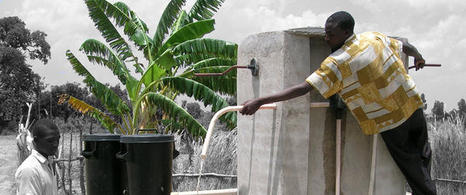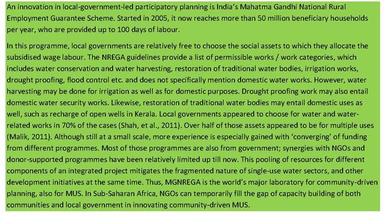Financing
Financing

The objective of this phase is to match costs and financing frameworks while overcoming the earmarks for single water use that used to be attached to financing streams and accountability in conventional water services. This can be achieved either by allowing for flexibility in allocation of financial resources or by converging different (sub)sectors in financing the provision of multiple use water services (like the water supply sector, the irrigation sector, the fisheries sector, etc.).
Financial resources for water interventions and the provision of water services are often earmarked to serve a particular single use, for instance, either water supply, or irrigation. Applying a multiple-use water services approach requires developing a financial framework that takes into account the costs of providing water services that serve multiple uses. Advocacy for widening of sub-sectoral mandates which will be needed for this is discussed in more detail in Part 3, while this phase focuses on how to match costs to the sources of funding.
OBJECTIVE
The objective of this phase is to match costs and financing frameworks while overcoming the earmarks for single water use that used to be attached to financing streams and accountability in conventional water services. This can be achieved either by allowing for flexibility in allocation of financial resources or by converging different (sub) sectors in financing the provision of multiple use water services (like the water supply sector, the irrigation sector, the fisheries sector, etc.).
ACTIVITIES
IDENTIFY (INCREMENTAL) LIFE-CYCLE COSTS OF THE PROVISION OF MULTIPLE USE WATER SERVICES
Based on the prioritised strategies, identify the required costs for the provision of multiple-use water services.
Going from providing single-use water services to providing multiple-use water services will come with incremental costs. These incremental costs can include:
- Capital (maintenance) expenditure of the technological add-ons such as a water treatment system added to an open canal irrigation system (irrigation-plus ) or a drip irrigation system added to a piped water supply system (domestic-plus).
- Additional operational and minor maintenance related to additional water use because of additional energy consumption.
- Additional costs of capital, related to additional loans.
- Additional direct and indirect support costs, related with the higher need for coordination between different sub-sectors, which comes at additional costs.
IDENTIFY POTENTIAL SOURCES OF FUNDING IN ORDER TO MEET THE LIFE-CYCLE COSTS
Identify potential sources of funding. These can include funding from governments (though taxes), from users (through tariffs), from donors (through transfers) and from individuals (through private funding).
Government funding, through taxes:
Governments generally cover direct and indirect support costs, through revenues from taxes (and / or transfers from donors). In case of multiple use services, direct and indirect support will mostly be multi-sectoral, ‘converging’ support from the water supply sector, as well as from the agricultural (extension) sector and livestock sector. Governments can also provide flexible funding that can be allocated as seen fit by local stakeholders (see NREGA, see Box 1).
Box 1 - Example of community-driven MUS: India’s Mahatma Gandhi National Rural Employment Guarantee Scheme

Tariffs (from users):
Tariffs are mostly used to cover operational and minor maintenance expenditure and occasionally part of the capital maintenance expenditure. A single tariff can be set, regardless of what the water is used for, or different tariffs can be set for different water uses. Different tariffs for different uses can be set in different ways:
- Different flat rates per household depending on the water use (for instance one tariff for people who use water only for domestic use, and another tariff for households who also use water for livestock).
- Increasing block tariff: volumetric tariff, which increases with the total amount of water used.
- Decreasing block tariff: volumetric tariff, which decreases with the total amount of water used.
- Tariff per production unit (for instance per unit land or per head of livestock).
Transfers from donors:
Donors mostly fund capital (initial investment costs and often maintenance) expenditure. A single donor can be identified to cover (part of the) the capital expenditure in order to provide multiple-use services, or separate donors can be identified to cover the capital (maintenance) expenditure associated with particular single uses.
Private funding:
As users of multiple-use water services will be able to obtain multiple benefits, the potential for self-financing of capital expenditure and operation and minor maintenance expenditure is likely to be higher for multiple use services that for single use services. Private sources of funding can include revenue from productive uses of water as well as micro-credit or other micro-financing mechanisms.
All these potential funding mechanisms have to be negotiated with the users, service providers and (potential) external funders of multiple-use water services in order to cover all the identified costs related to multiple use service provision. It is very likely that a mix of different funding sources is identified in order to fund the identified strategies for providing or improving multiple-use water services.
AGREE ON COST SHARING ARRANGEMENTS
Where multiple sources of funding have been identified, cost sharing arrangements have to be developed and signed. This is especially important for MUS because funding sustainable multiple-use water services is likely to require multiple sources of funding, crossing sub-sectoral boundaries.
TOOLS
The following tools can be useful to support the activities within this phase:
